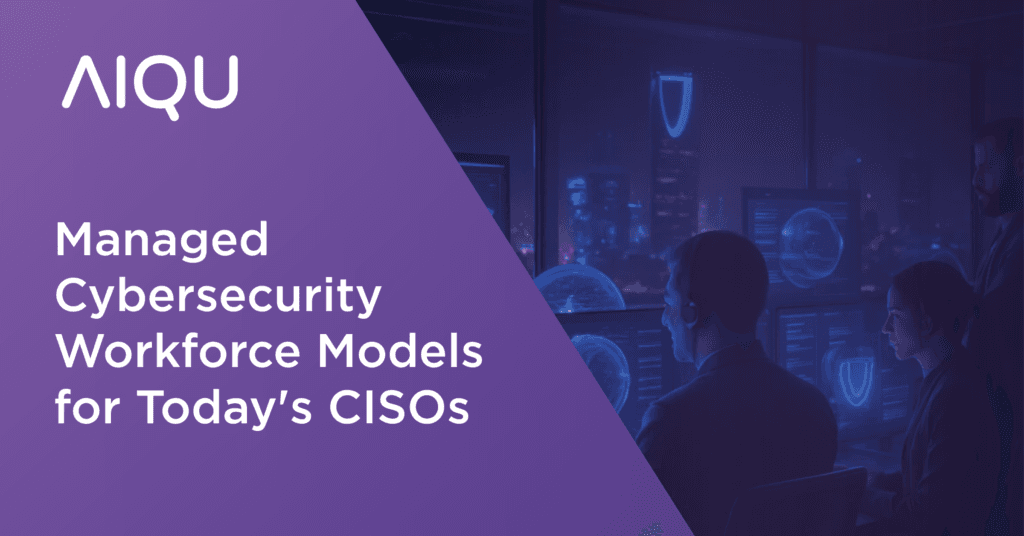
Managed Cybersecurity Workforce Models for Today’s CISOs
Cybersecurity threats continue to grow, and so does the pressure on security leaders. For today’s CISOs, staying ahead means more than just investing in new tools. It requires having the right people in the right roles.
But that’s a challenge. The cybersecurity workforce is stretched thin, and hiring qualified professionals has become harder than ever.
That’s where a managed cybersecurity workforce comes in. These flexible models help CISOs address critical staffing challenges, from 24/7 monitoring to specialized threat response. In this post, we’ll cover when and why to use them, how they work, and what makes them successful.
Let’s start with what’s driving the shift.
Why the Cybersecurity Talent Gap Is Fueling Change
The demand for cybersecurity professionals keeps rising, but the talent pool isn’t keeping up. Roles in threat analysis, incident response, and security operations remain open for months. Even when organizations find the right people, many leave due to burnout, better offers, or recruiter poaching.
At the same time, threats are constant. Organizations need continuous monitoring, fast response capabilities, and skilled teams to manage vulnerabilities. The traditional 9-to-5 model just doesn’t cut it.
Security platforms can help, but they’re not enough. You still need real people to analyze alerts, make decisions, and coordinate responses. Hiring across different time zones, shifts, and specialties is often out of reach for in-house teams.
That’s why more CISOs are turning to managed cybersecurity workforce solutions to stay agile and effective.
What Is a Managed Cybersecurity Workforce?
A managed cybersecurity workforce brings in external professionals via service providers or individual contractors to support or replace parts of your internal team. These professionals handle key tasks like threat detection, monitoring, or compliance support.
This form of cybersecurity workforce management gives CISOs flexibility when internal hiring isn’t feasible.
Here are the most common models:
Full Outsourcing
All cybersecurity operations are handled by a third-party provider, often a Managed Security Service Provider (MSSP). This model works well for smaller teams or organizations without an internal security operations center (SOC).
Co-Managed Services
Internal and outsourced teams collaborate. For instance, an MSSP might handle 24/7 threat monitoring while in-house analysts manage incident response. This model balances flexibility with internal control.
Staff Augmentation
Organizations temporarily add specialists through contractors or service firms. This approach is ideal when you need expertise in areas like cloud security, compliance audits, or threat hunting.
Each of these models helps fill gaps while giving CISOs room to adapt quickly to changing needs.
How CISOs Choose Managed Cybersecurity Workforce Solutions
Before selecting a model, CISOs should take a step back and assess the current state of their security teams.
Key questions to ask:
- Where are we experiencing the biggest cybersecurity workforce challenges?
- Can we support 24/7 operations internally?
- Do we need temporary support or long-term help?
- Are we better served by MSSPs, staff augmentation, or contractors?
Below is a breakdown of common options:
| Solution Type | Pros |
Cons |
| MSSP | 24/7 monitoring, rapid scalability | May offer less custom control |
| Contractors | Cost-effective for short-term needs | Availability and consistency vary |
| Staff Augmentation | Easy team integration | Often higher cost than direct hires |
When evaluating options, CISOs should also plan how external teams will be integrated. Do contractors have access to key tools and documentation? Are workflows shared across teams? Without alignment, even the best talent won’t be effective.
This evaluation phase is also when many leaders discover the broader value of cybersecurity talent outsourcing: flexibility, quicker response times, and stronger risk management.
Benefits of Cybersecurity Workforce Outsourcing for Enterprises
Outsourcing isn’t just about fixing a short-term problem. It solves real strategic challenges facing enterprise security teams.
Here are some of the top benefits:
- Scalability: Add or reduce headcount as needed without long hiring timelines.
- Speed to Deploy: External teams, especially MSSPs, are often ready within days.
- Access to Expertise: Get specialized security skills your internal budget might not allow full-time.
- Continuous Coverage: Global teams deliver 24/7 monitoring and response, crucial for high-risk industries.
Real-World Example
A healthcare enterprise struggling with alert fatigue adopted a co-managed SOC model. Their internal team focused on Level 2 incidents, while their MSSP filtered Level 1 alerts. As a result, incidents were resolved faster and staff experienced less burnout.
For many CISOs, the benefits of cybersecurity workforce outsourcing go beyond relief. It’s a smarter way to scale operations, manage risk, and stay resilient.
Security Operations Staffing Models That Actually Work
The most successful security teams don’t rely solely on internal staffing. Instead, they use proven workforce models that balance control, efficiency, and depth of expertise.
Here are three common approaches:
1. Co-Managed SOC Model
This hybrid model splits responsibilities between internal teams and an MSSP. The external team handles 24/7 monitoring, while internal staff focus on strategy, policy, and high-priority response. It offers resilience without giving up visibility.
2. Tiered Support Split
Outsource Level 1 support—alert triage and basic investigations—while keeping Levels 2 and 3 in-house. This setup ensures more complex issues receive the institutional knowledge they require while reducing the internal workload.
3. Fully Outsourced IR with Internal Coordination
In this model, the incident response function is fully outsourced, but internal leaders remain responsible for oversight and policy alignment. It’s effective during crises or in highly dynamic risk environments.
These security operations staffing models leave room to scale, shift, and respond quickly. The key to success is aligning each model with your strategic goals, compliance needs, and available resources.
Best Practices for Managing Outsourced Cybersecurity Teams
No matter the model you choose, execution matters. Misaligned or siloed teams can become a liability instead of a strength.
Here are five best practices for managing outsourced cybersecurity teams:
- Maintain Visibility
Use dashboards, shared tools, and centralized reporting to keep internal leaders informed.
- Establish Clear Communication
Set regular syncs, build direct chat channels, and align on escalation procedures from day one.
- Define Performance Metrics
Use SLAs and KPIs to track response times, service levels, and overall effectiveness.
- Integrate Day-to-Day Workflows
Make sure outsourced teams follow the same ticketing and documentation standards as internal staff.
- Ensure Compliance and Security
Onboard all third-party personnel thoroughly. Require relevant certifications and conduct regular audits.
Applying these standards helps CISOs turn outsourced support into a seamless part of their overall cybersecurity strategy.
Smart Cybersecurity Workforce Models Help CISOs Do More With Less
Cybersecurity workforce management is no longer just about hiring in-house. Today’s challenges require flexible, scalable solutions especially for enterprises facing constant change and limited resources.
Using a managed cybersecurity workforce allows CISOs to scale up without the delays of traditional hiring. Whether you’re tapping into an MSSP, bringing in specialized contractors, or combining models through a co-managed approach, these strategies help you maintain resilience and reduce burnout across your team.
With the right model and the right partner, CISOs can protect more, respond faster, and focus on long-term cybersecurity strategies instead of constant staffing battles.
FAQ: Managed Cybersecurity Workforce Models
- What’s the main advantage of a managed cybersecurity workforce?
It helps CISOs scale quickly by adding skilled professionals without the lead time required for traditional hiring.
- How do I ensure outsourced cybersecurity teams follow internal standards?
Build detailed SLAs, train external teams on your internal tools and policies, and keep workflows tightly integrated.
- Is it safe to use managed cybersecurity teams in regulated industries?
Yes, if you choose partners with a strong track record in compliance. Many MSSPs specialize in meeting the strict requirements of industries like healthcare and finance.
Smart, flexible staffing is now a foundational part of CISO cybersecurity strategies. With thoughtful planning and the right partnerships, managed cybersecurity workforce solutions help teams stay ahead of ever-growing threats without sacrificing control.


